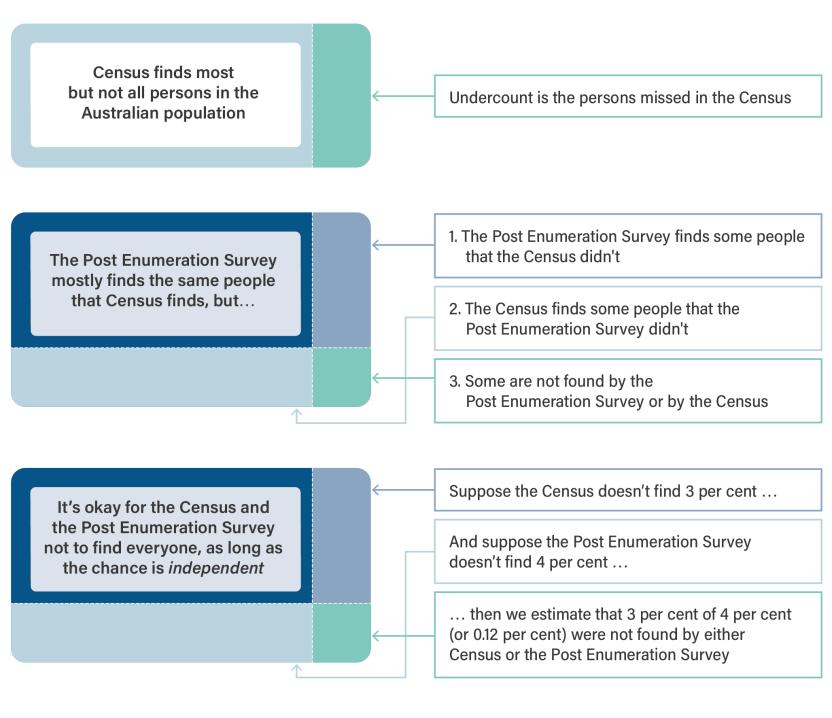
B.1.1 Assessment of Census coverage – overcount and undercount
The Post Enumeration Survey provides an assessment of Census coverage, or how successful the Census was in counting the total Australian population. This assessment is determined in terms of overcount and undercount.
Some of the reasons why people are counted more than once or counted in error (i.e. overcounted) include:
- they were included on the Census form at the dwelling where they usually live, even though they stayed and were counted elsewhere on Census night; and
- they were overseas on Census night and so should not have been counted at all, but were included on the Census form at the dwelling where they usually live.
Some of the reasons why people may be missed (i.e. undercounted) include:
- they were travelling and were difficult to contact;
- they mistakenly thought they were counted elsewhere;
- the person completing the form thought that, for example, young babies, the elderly or visitors should not be included;
- they did not wish to participate;
- the dwelling in which they were located was missed because it was difficult to find (e.g. in a remote or non-residential area); and
- the dwelling in which they were located was mistakenly determined to be unoccupied.
Rates of overcount and undercount can also vary significantly for different population groups depending on factors such as sex, age, ethnicity, Aboriginal and Torres Strait Islander origins, and geographic location.
B.1.2 Occupancy and an assessment of Census imputation
The Post Enumeration Survey also provides an assessment of the total number of persons present in dwellings where Census have imputed persons. Imputation is the process that attempts to fill in basic information for the people who didn’t respond to the Census. Currently, this information is a person’s age, sex, usual residence and marital status. For these dwellings, the Post Enumeration Survey makes an entirely independent assessment of the number of persons who usually reside in these dwellings, based on the subset of sampled dwellings that match to Census dwellings where imputation has occurred. The net overcount for persons imputed[1] is derived by subtracting the Post Enumeration Survey estimate from the total of Census imputed persons. If Census under imputes persons, then the result is a net undercount for persons imputed.
Because the Post Enumeration Survey cannot directly associate person records with Census imputed persons, there is no precise way to break down the components of overcount and undercount. Approximate comparisons can be made by examining the characteristics and occupancy of Post Enumeration Survey dwellings that match to Census dwellings where imputation has occurred.
Some of the reasons why Census may over or under impute include:
- private dwellings were incorrectly identified as occupied on Census night (leading to over-imputation);
- private dwellings were correctly identified as occupied on Census night, but too many or too few persons were imputed;
- non-private dwellings had too many or too few persons imputed.
Rates of over-imputation can also vary significantly for different population groups depending on factors such as sex, age, ethnicity, Aboriginal and Torres Strait Islander origins, and geographic location.
[1] For technical reasons, the Post Enumeration Survey groups dwellings where Census has imputed people together with dwellings where a Census form was received after the start of the Post Enumeration Survey collection (‘Late Returns’) and people who provided insufficient personal identifier information on their Census form, as these groups all require the Post Enumeration Survey to make an independent estimate of the true population. However, the size of net overcount for imputed people is much larger than the undercount or overcount from the other components, so the net overcount for this group can safely be interpreted as over-imputation.
B.1.3 Assessment of Census data quality
The Post Enumeration Survey provides information on overcount and undercount for the following variables, and as such, provides an indication of their quality:
- Geography (national, state and/or territory, and part of state and/or territory);
- Age;
- Sex;
- Marital status;
- Country of birth; and
- Indigenous status.
Note that ‘not-stated’ or missing values for Country of birth and Indigenous status are not imputed in the Census. Those persons who have a value of ‘not-stated’ against either of these two items contribute to net undercount estimates for the category in which they should have been counted, as reported in the Post Enumeration Survey.





